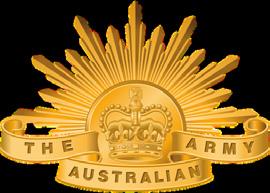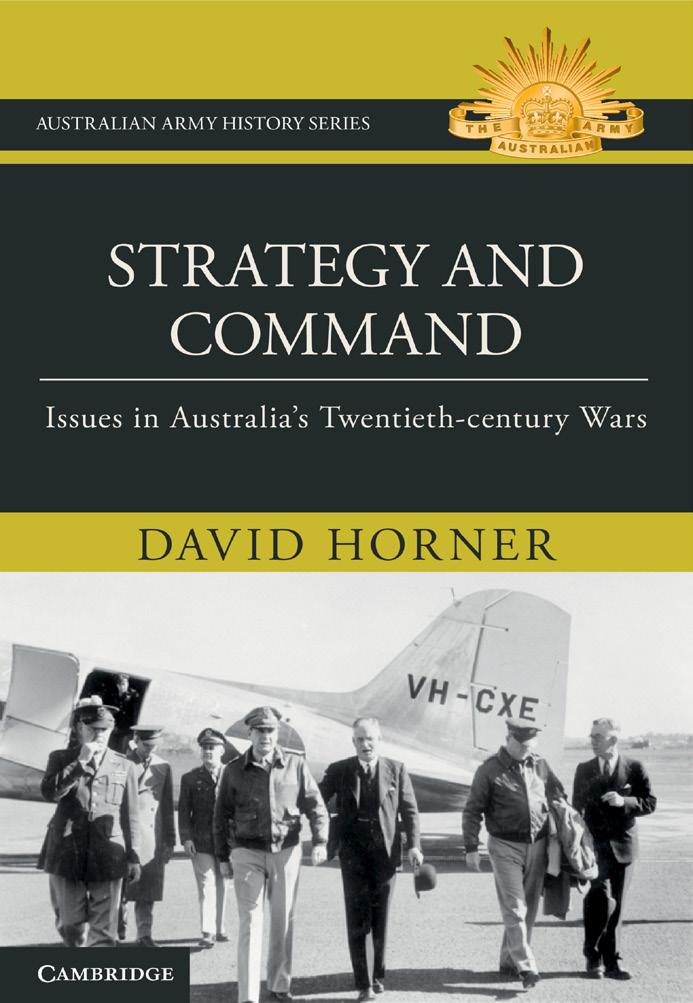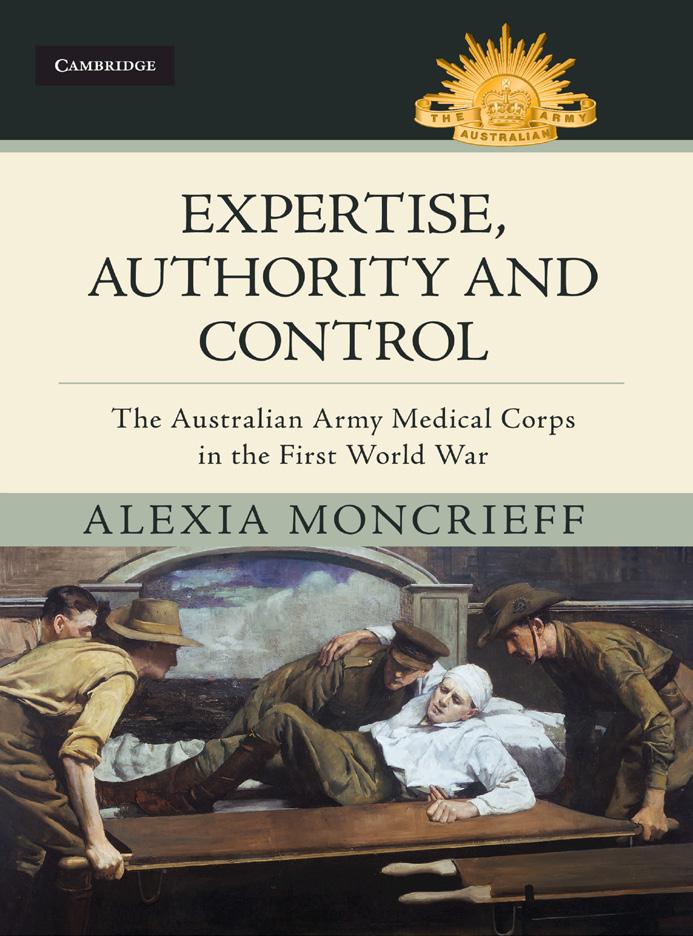

Australian Army History Series


For reading copies and sales enquiries, please contact jacqueline.gray@cambridge.org
NOTE: All books featured in this catalogue, including those that are printed on demand, are returnable as part of your normal allowance.
The partnership between the Australian Army and Cambridge University Press aims to produce high quality military history for a world-wide audience. Focused on the history of the Army, its people and its role in the development of the nation, the Australian Army History Series provides readers with fresh, academically rigourous titles written by the nation’s pre-eminent military historians. The Army is pleased to collaborate with one of the world’s most respected publishers in promoting our proud and distinct military history and heritage.





9781009603812
Hardback
AUD $59.95 / NZD $64.95
Available December 2025
Lewis Frederickson, University of New South Wales
Key Features
• The text presents an engaging account of the birth and continuing impact of the Anzac legacy
• Emphasis on a critical and comparative analysis of the development of the Australian infantry throughout
• Written by a serving officer in the Royal Australian Air Force with extensive teaching experience in history and strategy
After Anzac
The Development of Australian Infantry on the Western Front, 1916—1918
About
By the end of the ‘Great War’, the Australian and New Zealand Army Corps (ANZAC) had a reputation for being one of the most effective formations on the Western Front. After Anzac provides a critical and comparative analysis of how Australian infantry developed to embody this reputation, primarily as an element of the greater Imperial Force.
The book opens with a comparison of the Australian Imperial Force (AIF) to the Canadian Expeditionary Force (CEF); both were Dominion formations who trained and developed under the British Expeditionary Force (BEF). Various AIF training and development instructed by the BEF are then explored, including infantry recruit and tactical training, weapons systems and specialist training, culminating in a critical analysis of how this resulted in the effectiveness and professionalism of Australian troops who served on the Western Front. The impact of the Anzac legend and the mythology of the Western Front are considered.
About the Author
Lewis Frederickson is a serving officer in the Royal Australian Air Force. He previously lectured in the history and strategy of air power as the Chief of Air Force Fellow at the University of New South Wales, Canberra. He has a passion for academic and vocational education in both the air and land domains and how these themes intersect in Australian history.


9781009637671 Hardback
AUD $59.95 / NZD $64.95
Available December 2025
Ian R. Finlayson
Key Features
• Dedicated overview of how the Australian Army structured its logistics to support operations in Vietnam, rather than a focus on combat operations
• Overarching case study of the strengths and weaknesses of relying on US Army logistic support in combined operations
• Authored by a retired logistics officer with over 40 years Army experience
Supporting the Commitment
Australian Army Logistics In South Vietnam, 1962—1973
About
In 1962, the Australian Government deployed Australian military forces in support of the Republic of Vietnam. Supporting the Commitment: Australian Army Logistics in South Vietnam 1962–1973 investigates how the Australian Army structured its logistics to support its operations in Vietnam.
This book examines how the Australian Army interacted with the U.S. Army’s logistic framework to secure its own logistic support for the training team, the battalion group and then the task force. Particular attention is given to the logistic units which supported these deployments, including the raising, siting and operations of 1st Australian Logistic Support Group (1ALSG), and the role that 1ALSG played in the support, draw down and withdrawal of Australian forces. Acknowledging that the Australian Army’s involvement in South Vietnam was a war of choice, the book explores how Army’s institutional attitudes towards logistics influenced the nature of support provided.
About the Author
Ian R. Finlayson is a retired logistics officer and a graduate of the Australian Army Command and Staff College (Queenscliff). He has over 40 years of Army service in a wide range of staff and regimental appointments.


9781009597814
Hardback
AUD $59.95 / NZD $64.95
Available July 2025
Thomas Richardson, University of New South Wales, Canberra
Key Features
• This text presents the first analytical history of the Australian Army in South Africa
• Focus on the ‘bushmen experiment’ and Australian’s as ‘natural soldiers’
• Written by a historian with extensive research experience
Soldiers and Bushmen
The Australian Army in the South African War, 1899—1902
About
Soldiers and Bushmen: The Australian Army in the South African War, 1899–1902 examines the commitment to what was expected to be a short war. It presents a thematic, analytical history of the birth of the Australian Army in South Africa, while exploring the Army’s evolution from colonial units into a consolidated federal force. Soldiers and Bushmen investigates the establishment of the ‘bushmen experiment’ – the belief that the unique qualities of rural Australians would solve tactical problems on the veldt. This, in turn, influenced ideals around leadership, loyalty and traditional combat that fed the mythology of the Australians as natural soldiers. The book also examines the conduct of the war itself: how the Army adapted to the challenges of a battlefield transformed by technology, and the moral questions posed by the transition to fighting a counterinsurgency campaign.
About the Author
Thomas Richardson is a historian at University of New South Wales, Canberra. He specialises in Australian military history, and histories of insurgency and counterinsurgency.


9781009431811
Hardback
AUD $59.95 / NZD $64.95
Available August 2024
Matthew E. Miller
Assault Brigade
The 18th Australian Infantry Brigade in World War II
About
The Australian Army served in numerous theatres and campaigns throughout World War II, earning distinction and at times facing significant challenges. During the Pacific War, the infantry brigade, as an intermediate formation commanding multiple infantry battalions and numerous attached units, was key in Australian efforts to secure victory. The 18th Infantry Brigade participated in a variety of combat operations with a range of allies allowing it rare experience among Australian units. It’s involvement in operations from Europe to the Middle East and onto the Pacific ensured that it was one of the most modern brigades at the close of the war. Assault Brigade examines the challenges and development of the Australian Army’s 18th Infantry Brigade throughout World War II. It investigates a series of campaigns fought across the South West Pacific Area, highlighting lessons learnt and adaptations implemented as a result of each battle.
Key Features
• Written by a Senior Historian with over thirty years of active and reserve service
• This text presents the first examination of the Australian 18th infantry brigade in World War II
• Focus on evolution of the brigade across campaigns
About the Author
Matthew E. Miller is a Senior Historian at the United States Special Operations Command and is responsible for managing the battlefield historical collection. He has over thirty years of active and reserve service in the United States military and holds degrees from the University of California San Diego, the London School of Economics and a Ph.D. in History from the University of New South Wales, Canberra at the Australian Defence Force Academy.


9781316512371
Hardback
AUD $62.95 / NZD $67.95 October 2021
David Horner, Australian National University
Key Features
• Comprehensive coverage of the Australian army’s engagements across the 20th century
• Written by one of Australia’s leading military historians
• Insightful discussion of strategy and command
Strategy and Command Issues in Australia’s
Twentieth-century Wars
About
In Strategy and Command, David Horner provides an important insight into the strategic decisions and military commanders who shaped Australia’s army history from the Boer War to the evolution of the command structure for the Australian Defence Force in the 2000s. He examines strategic decisions such as whether to go to war, the nature of the forces to be committed to the war, where the forces should be deployed and when to reduce the Australian commitment. The book also recounts decisions made by commanders at the highest level, which are passed on to those at the operational level, who are then required to produce their own plans to achieve the government’s aims through military operations. Strategy and Command is a compilation of research and writing on military history by one of Australia’s preeminent military historians. It is a crucial read for anyone interested in Australia’s involvement in 20th-century wars.
About the Author
David Horner is one of Australia’s leading historians and is based at the Australian National University. He was Professor of Australian Defence History at the university for fifteen years and is considered Australia’s premier military historian with an international reputation for military history and strategic analysis.


Expertise, Authority and Control
The Australian Army Medical Corps in the First World War
9781108478151
Hardback
AUD $64.95 / NZD $70.95
February 2020
Dr Alexia Moncrieff, University
of Leeds
About
Expertise, Authority and Control charts the development of Australian military medicine in the First World War in the first major study of the Australian Army Medical Corps in over seventy years. It examines the provision of medical care to Australian soldiers during the Dardanelles campaign and explores the imperial and medical-military hierarchies that were blended and challenged during the campaign. By the end of 1918, the AAMC was a radically different organisation. Using army orders, unit war diaries and memoranda written to disseminate information within the Australian Imperial Forces (AIF) and between British and Australian soldiers, it maps the provision of medical care through casualty clearance and evacuation, rehabilitation, and the prevention and treatment of venereal disease. In doing so, she reassesses Australian military medicine and maps the transition to an infrastructure for the AIF in the field, especially in response to conflicts with traditional imperial, military and medical hierarchies.
Key Features
• The first major study of the Australian Army Medical Corps in over seventy years
• Takes an exhaustive approach, mapping the provision of medical care through casualty clearance and evacuation, rehabilitation and the prevention and treatment of venereal disease
• Reassesses Australian military medicine and maps the transition to an infrastructure for the AIF in the field, especially in response to conflicts with traditional imperial, military and medical hierarchies
About the Author
Dr Alexia Moncrieff is a Postdoctoral Research Fellow in the School of History at the University of Leeds.


Surviving the Great War
Australian Prisoners of War on the Western Front, 1916—18
9781108486194
Hardback
AUD $64.95 / NZD $70.95
November 2019
Aaron Pegram, Australian War Memorial
Key Features
• Provides the first detailed analysis of Australians in German captivity in the First World War on the Western Front
• Places the experiences of prisoners of war in a broader social and military context, thus adding a new dimension to the national wartime experience
• Challenges popular representations of Australia’s involvement in the First World War
About
Between 1916 and 1918, more than 3,800 men of the Australian Imperial Force were taken prisoner by German forces fighting on the Western Front. Australians captured in France and Belgium did not easily integrate into public narratives of Australia in the First World War and its commemorative rituals. Captivity was a story of surrender and inaction, at odds with the Anzac legend and a triumphant national memory. Soldiers captured on the Western Front endured a broad range of experiences in German captivity, yet all regarded survival as a personal triumph. Surviving the Great War is the first detailed analysis of the little-known story of Australians in German captivity in the First World War. By placing the hardships of prisoners of war in a broader social and military context, this book adds a new dimension to the national wartime experience and challenges popular representations of Australia’s involvement in the First World War.
About the Author
Aaron Pegram is a Senior Historian in the Military History Section at the Australian War Memorial.


9781108471497
Hardback
AUD $64.95 / NZD $70.95
February 2019
Romain Fathi, Flinders University of South Australia
Our Corner of the Somme
Australia at Villers-Bretonneux
Key Features
• Provides a new interpretation of famous events from the First World War
• Details the often-unseen political influences that helped shape a national memory of the First World War
• Questions the well-established notion of Anzac valour in the Battle of the Somme
About
By the time of the Armistice, Villers-Bretonneux - once a lively and flourishing French town - had been largely destroyed, and half its population had fled or died. From March to August 1918, Villers-Bretonneux formed part of an active front line, at which Australian troops were heavily involved. As a result, it holds a significant place in Australian history. Villers-Bretonneux has since become an open-air memorial to Australia’s participation in the First World War. Successive Australian governments have valourised the Australian engagement, contributing to an evolving Anzac narrative that has become entrenched in Australia’s national identity. Our Corner of the Somme provides an eye-opening analysis of the memorialisation of Australia’s role on the Western Front and the Anzac mythology that so heavily contributes to Australians’ understanding of themselves. In this rigorous and richly detailed study, Romain Fathi challenges accepted historiography by examining the assembly, projection and performance of Australia’s national identity in northern France.
About the Author
Romain Fathi, Ph.D., is Lecturer in History at Flinders University of South Australia and a Chercheur associé at the Centre d’Histoire de Sciences Po, Paris. He has taught and researched at Sciences Po in France, Yale in the United States, and the University of Queensland in Australia. His primary research interests focus on the First World War, war commemorations and Australian identity.

